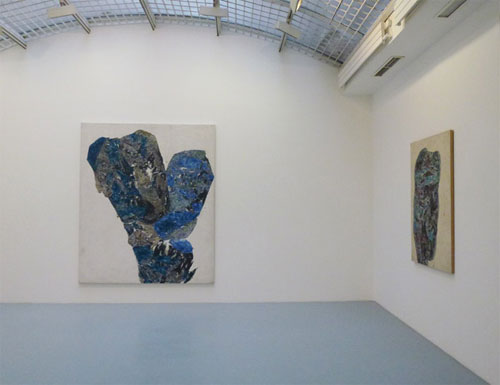HANTAI – FOURNIER
Simon Hantaï
Panses 1964 – 1965
Jean Fournier Gallery is proud to present an exhibition dedicated to a rarely shown series by Simon Hantaï Panses [Paunches], dating from 1964 and 1965.
The exhibition follows, « Displace, Disclose, Discover », organized by Marc Donadieu, which took place at the LaM in Villeneuve d’Ascq from March to May of 2012 and where the paintings of this same series were gathered.
A early as 1967, for the first time Jean Fournier showed in his gallery rue du Bac, a major selection of important small works from the Panses series, in the context of the exhibition « Peintures 1960 – 1967 ». This selection was noticed at the time by young artists such as Pierre Buraglio, Daniel Buren, Jean-Michel Meurice or Michel Parmentier.
The beginning of the sixties represents a fundamental stage in the work of Simon Hantaï. It was the birth of the « pliage comme méthode » (folding method). This quasi archaic method shows the willingness of the artist to start all over again, to voluntarily give up what he knows and what he knows how to do, while integrating a method that forces him to paint blind, escaping permanently to the « I » of the painter. Two series were made following the folding method before the Panses : the Mariales 1960-1962 and the Catamurons 1963-1964. Then the Meuns 1967-1968, the Etudes 1969-1970; the watercolors on canvas in 1971, the Blancs 1973-1974 and then the Tabulas the first ones of which were made from 1972 until the 80’s and finally the Laissées, canvases left-over from the Tabulas that the artist reworked at the end of the 80’s, beginning of the 90’s.
The Panses series was initially entitled: Maman, Maman! Dits : la saucisse, referring to a text by Henri Michaux : « Everything, truly everything, is to be taken up again from the beginning : from the cellules, of plants, of molluscs, of proto-animals : the alphabet of life. […] The cellule might still save the world, it alone, cosmic sausage without which one can no longer defend oneself. »[1]
Thus, from 1964 to 1965, the canvases which Hantaï proceed to fold multiple times, one single-shape, while tying the canvas at each of the four angles in a egg-shaped bag, leaving an important peripheral space for the white. The colored space layers itself in the center of an intense chromatic fluctuation mixing earthy colors into blues, pinks and sometimes-luminous greens.
Georges Didi-Huberman, in his book L’Etoilement, conversation avec Hantaï, evokes this series in stipulating that it « refer explicitly to a set of problems having to do with gestation and childbirth. The same word in Hungarian, explains Hantaï, the same both « rude and very beautiful » word, used sometimes to describe a « full » woman or a « sausage » which is eaten after a pig is killed. Today with several meanings in French Hantaï names it panse. If the painting thinks (pense in French), it first has to realize, like panse, what it is capable of delivering materially: to know Hantaï’s paintings, is an intimate access to the work, a dialectic of folding and pigmentary consequences or (intense) chromatics, non-compositional or touching (extensions). »
On the eve of the retrospective of the artist that will take place at the National Museum of Modern Art, Georges Pompidou Center from May to September 2013, this exhibition will show all the importance of the Panses series in the works of Simon Hantaï.
Publication of an exhibition catalogue with texts by Molly Warnock and Karim Ghaddab, Lienart Edition and Jean Fournier Gallery.
